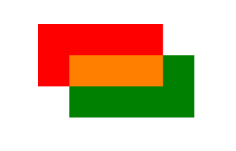This is a library for declarative use of Canvas API with Angular.
If you do not have @ng-web-apis/common:
npm i @ng-web-apis/commonNow install the package:
npm i @ng-web-apis/canvasAdd CanvasModule to your module declaration and use waCanvas2d directive on a
canvas element to declare 2D context scope. Then
use other directives to draw inside canvas:
<canvas waCanvas2d>
<canvas-path fillStyle="red">
<canvas-rect
[x]="0"
[y]="0"
[width]="100"
[height]="50"
></canvas-rect>
</canvas-path>
</canvas>Context directive supports the following attributes (see contextAttributes for 2D context):
-
opaque—booleanattribute to setalphatofalse -
desynchronized—booleanattribute to setdesynchronizedtotrue
There are 3 types of directives you can use:
- Method directives
- Properties directives
- Path directives
These are basic directives to draw things on canvas.
canvas-clip-pathcanvas-draw-imagecanvas-text-
canvas-path- You can use
pathinput to passPath2D
- You can use
These directives set properties of
CanvasRenderingContext2D. They must be
applied to a method directive and they change context property before calling the method. They also restore default
value after drawing is performed so it will not interfere with the rest of picture.
-
clip- Either pass a reference to
canvas-clip-pathdirective or aPath2Dobject
- Either pass a reference to
clipFillRuledirectionfillStylefilterimageSmoothingEnabledimageSmoothingQualityfontglobalAlphaglobalCompositeOperationlineCaplineDashOffsetlineJoinlineWidthlineDashmiterLimitstrokeStyletextAligntextBaselineshadowBlurshadowColorshadowOffsetXshadowOffsetYtransform
You can use following directives to draw path on Canvas. They must be children of canvas-path directive:
canvas-arccanvas-arc-tocanvas-bezier-curve-tocanvas-ellipsecanvas-line-tocanvas-move-tocanvas-quadratic-curve-tocanvas-rect
Combining properties, method and path directives can be examined on the following case. Consider drawing two rectangles with native commands:
function drawTwoRectangles(context) {
context.beginPath();
context.fillStyle = 'red';
context.rect(0, 0, 100, 50);
context.fill();
context.beginPath();
context.fillStyle = 'green';
context.globalCompositeOperation = 'screen';
context.rect(25, 25, 100, 50);
context.fill();
context.fillStyle = '#000';
context.globalCompositeOperation = 'source-over';
}This is equivalent to the following HTML
<canvas waCanvas2d>
<canvas-path fillStyle="red">
<canvas-rect
[x]="0"
[y]="0"
[width]="100"
[height]="50"
></canvas-rect>
</canvas-path>
<canvas-path
fillStyle="green"
globalCompositeOperation="screen"
>
<canvas-rect
[x]="25"
[y]="25"
[width]="100"
[height]="50"
></canvas-rect>
</canvas-path>
</canvas>And both will give you this result:
You can use Pipes to create some of the classes, required for particular Canvas operations:
-
gradientto create CanvasGradient -
pathto create Path2D -
patternto create CanvasPattern -
radto convert degrees into radians -
transformto convert CSS transform string into DOMMatrix
- Performance-wise it would of course be slower than performing imperative commands and optimizing them manually. But unless you are making a video game with heavy render cycle this shouldn't be noticeable.
- Unlike raw canvas, default stroke color is transparent to align behavior with SVG.
Other Web APIs for Angular by @ng-web-apis



